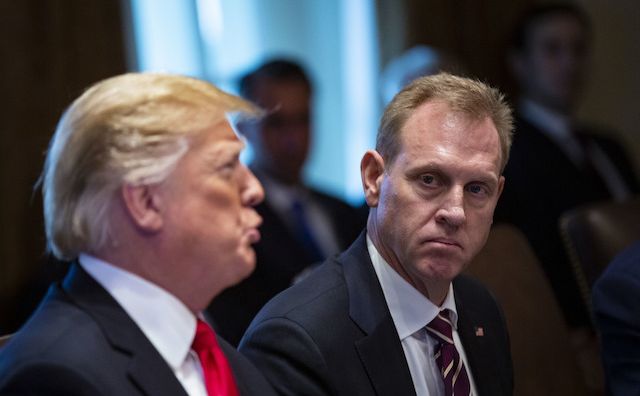Post-Mattis uncertainty and the future of U.S. defense policy
U.S. Defense Secretary Patrick Shanahan is not expected to reverse his predecessor Gen. James Mattis’ key Pentagon policies. Thus, Trump may find out that his ambitious plan for force strengthening and modernization proves even more difficult to push through Congress in the absence of a well-recognized figure at the Pentagon.

In a nutshell
- Gen. James Mattis doubted that the nation’s overextended military could count on significantly higher funding in the coming years
- The former Pentagon chief pushed programs to make U.S. forces more mobile and combat-ready, and called for limiting overseas deployments
- Acting Defense Secretary Patrick Shanahan is an interim, caretaker figure most likely to be replaced soon by someone with more clout
On December 21, 2018, United States Defense Secretary James Mattis announced his resignation. He left office a little over a week later. His deputy, Patrick M. Shanahan, became the acting secretary. How long Mr. Shanahan will keep the top post and how defense policies will change following retired General Mattis’ departure are two questions of significant importance for the next two years of Donald Trump’s presidency. In the short term, expect few significant shifts in direction. The status quo, however, might not endure long.
Thus far, Mr. Shanahan has taken care to send signals that he planned no big deviations from his predecessor’s course. During his tenure, Secretary Mattis identified readiness as the top challenge facing the Defense Department. He devoted significant departmental resources and much of his personal attention to the issue. Last year, for example, the secretary put together a project aimed at achieving a minimum of 80 percent mission-capability rates for the nation’s fighter aircraft fleet, a goal significantly above the current rates.
Making do with less
At the same time, Gen. Mattis directed senior defense leaders to be sparse in discussing the problem in public. “There’s been no direction to not talk about readiness issues,” then-press secretary Dana White told reporters, “[t]he secretary wants his commanders to talk about readiness.” Yet, it was clear that Mr. Mattis did not want to acknowledge the shortfalls, lest potential enemies miscalculated. The policy created tensions. “I admit, it’s a fine balance,” Mac Thornberry, the senior Republican on House Armed Services Committee, told the press. However, he continued, “if we’re going to convince my colleagues who are not on this committee, as well as the American people, to fix these things, I think we do have to at least talk somewhat openly about what our problems are.” Mr. Shanahan, on his part, looks to continue the policy.
The acting secretary also stands by his former boss’ view that U.S. forces were over-deployed and over-extended.
Secretary Mattis was skeptical that the low readiness risk could be mitigated through a significant higher topline for the Defense Department budget. Though President Trump committed to seeking a $750 billion budget for fiscal year 2020, he will have a hard time pushing such a budget through a divided and partisan Congress. Well aware of that, Mr. Mattis looked to a concept he called “Dynamic Force Deployment,” where the U.S. would develop better means to move limited forces around quickly to where they are required. Last year, NATO conducted exercise Trident Juncture in Norway, Iceland, Sweden and Finland. It was meant to demonstrate the capability to rapidly reinforce the alliance’s northern flank in the case of a Russian incursion. Trident Juncture was indicative of how Secretary Mattis expected the U.S. forces to respond globally. Mr. Shanahan claims to be committed to this idea.
Too large footprint
The acting secretary also stands by his former boss’ view that U.S. forces were over-deployed and over-extended and a reduction of the U.S. footprint in the Middle East, Africa and Afghanistan was in order. This has led to significant tensions within the U.S. government and with friends and allies. Balancing purposeful withdrawal without undermining U.S. interests is a challenging task. Particularly in the Middle East and in Afghanistan, it has already proven far more protracted and complicated than expected. The details of how to adjust the footprint was a great source of friction between Gen. Mattis, the National Security Council, the State Department and the White House. Mr. Mattis’ letter of resignation suggested that the friction contributed to his decision to leave. That strain is not likely to go away.
The Pentagon’s unease with further deployment commitments creates additional tensions. The administration, for example, seems increasingly interested in deploying forces in Poland, an initiative at odds with Mr. Mattis’ smaller footprint concept. At present, the Department of Defense seems set to continue endorsing a compromise: a permanent U.S. “flag on the ground” but a rotational force structure (details to be determined).

Modernization needs
Another area of continuity from Mr. Mattis to Mr. Shanahan regards strategic issues. The Pentagon remains committed to modernizing the nuclear triad (missiles, bombers, and submarines) and the U.S. nuclear arsenal. The administration, though, continues to fret that Congress may not provide the resources needed to keep the program on track. Of particular concern is the criticism of the nuclear modernization program from Adam Smith, the new chair of the House Armed Services Committee, who has been the chief spokesperson of Democratic opposition to President Trump in Congress.
The Defense Department recently released its Ballistic Missile Defense Review, which outlines the U.S. assessment of threats and acquisition of future capabilities. The plan is basically a “status quo” document. It embraces continued support for expanding missile defense capabilities, but not new commitments. This reflects Gen. Mattis’ caution; he assumed that there would not be enough money to improve readiness and sustain current operations, as well as undertake major modernization programs or expand the current force.
The president from day one has been the ‘decider-in-chief’.
Meanwhile, the U.S. defense policy community strongly supported the proposal to withdraw from the Intermediate-Range Nuclear Forces treaty. Mr. Mattis endorsed a course of action where the U.S. would look to counter the Russians in the near term with a mix of intermediate-range weapons. That policy has been adopted and it is one Mr. Shanahan will continue to support.
Junior partner
While defense policies look fairly stable in the near term, there are open questions. One is the impact Mr. Mattis’ departure will have on senior decision-making. There never was an “axis of adults,” as in the allegation that President Trump’s foreign and defense policy was under the control of senior advisors. The president from day one has been the “decider-in-chief.” Further, no particular senior advisor has a dominating influence on Mr. Trump, though on particular issues the opinions of several advisors and cabinet officials have been crucial. Acting Secretary Shanahan, however, is very much the junior partner compared to the influence of Secretary of State Mike Pompeo and National Security Advisor John Bolton. Furthermore, General Joseph Dunford, the chairman of the Joint Chiefs of Staff, is a lame-duck, with Army General Mark Milley selected by the president as his successor. How Mr. Shanahan’s voice counts in the next bid decision or moment of crisis remains an open question.
There are reports that the acting secretary is not popular within the department or among Congressional leaders, and clearly, he is not known among international leaders. Two of the great challenges Mr. Shanahan will face is securing adequate resources and explaining President Trump’s policies to the world. Gen. Mattis was never fully comfortable engaging with Congress nor did he prioritize this aspect of his work. His successor starts with a mediocre state of Congressional relations he has inherited.
Expect the president to appoint a new defense secretary before the summer starts.
On the other hand, Secretary Mattis was superb at explaining U.S. policies to global leaders who were often frustrated as they tried to decode the last Trump tweet. Mr. Mattis’ resignation suggested his discomfort with this role. Mr. Shanahan is neither as well-known nor as well-respected as his predecessor. So, this too will be a difficult part for him to play.
Defense budget
If the president does keep Mr. Shanahan in place, the administration may find it more difficult to “sell” its policies to Congress, and friends and allies, adding to the already difficult job of advancing its defense and security policy for the next two years.
The most likely short-term scenario is that pressures on defense policy will result in Mr. Shanahan never advancing from acting to full defense secretary. Expect the president to appoint a new secretary before the summer starts. One can also expect administration-congressional relations on defense matters to reach their nadir of the administration. It is unlikely that Congress will pass a defense budget for FY2020. That said, it is also unlikely that defense spending will be significantly reduced.
Defense might well receive substantial supplementary Overseas Contingency Operations funding. There is also a strong possibility that, for the first time in decades, Congress will be unable to pass the National Defense Authorization Act. There is a caveat here, though: the closer to national elections, the less likely the president will be to replace Mr. Shanahan. If the acting secretary manages to weather the next few months, he will be quite likely to stay on the job until the end of Mr. Trump’s first term. Under such a scenario, the president will likely have to fight a more uphill battle to finance his plan for the U.S. military.







